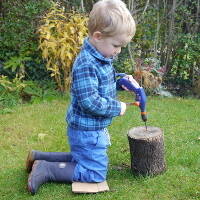
Woodwork tools & tips
Recommended woodwork tools from Early Years woodworking expert Pete Moorhouse.
Read More about Woodwork tools & tipsPete Moorhouse is the UK’s leading authority on woodworking in Early Years education and has written several books and journal articles.
In this introduction to our Woodworking & Tools section Pete tells us about the benefits of woodwork in the Early Years and shares some very useful resources.

“I’m passionate about encouraging creativity in education. I’m a professional sculptor and have also been working in education as an artist educator for over 25 years. I’m really interested in developing children’s creative and critical thinking skills thorough various open-ended explorations and investigations.
I am also a research fellow at the University of Bristol, focusing on how creative progression can be monitored and developed. I explore many mediums with children but woodwork has always stood out as being particularly special. It engages children so profoundly, throwing up countless problems, and children have that intrinsic motivation to persevere and resolve their work – there really is a special magic! My practice is inspired by Froebellian principles and the practice in Reggio Emilia.
I am an associate trainer for Early Education and deliver training and keynote presentations both nationally and overseas.
Pete.”
Pete shares a little more of his knowledge and enthusiasm below.
These are exciting times. Currently there is a surge of interest in woodwork provision in early childhood education right around the world. In an ever increasing number of settings we can here the tap-tapping of hammers and the sawing of wood. Woodwork has a long tradition within early years ever since the days of Froebel over 180 years ago.
Woodwork was almost eradicated in the 80s and 90s due to fears of litigation and overzealous health and safety concerns but is now making a comeback due to more balanced attitudes towards risk. Health and safety measures are there to help children do activities safely not prevent them and deny opportunity. It is important young children get to experience risk in a controlled environment contributing to their development by learning to self-manage and make decisions.
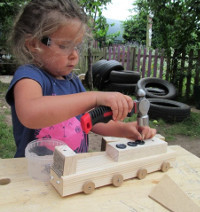
The rise of woodwork provision is very welcome and it is good news for children – as they really enjoy it. Anyone who has witnessed young children deeply engaged, tinkering away with tools will know just how magical it can be. The benefits of woodwork for children’s learning and development are immense across all areas of learning and children show the most extraordinary levels of concentration and engagement for sustained periods of time.
The renewed interest, is in part a reaction to our increasingly digital world. We are seeing a new generation of children that have learnt to swipe before they can walk, and woodwork can be seen as a wonderful medium to engage children allowing them to explore their physical world with real tools and authentic materials. Globally there has been a upsurge in ‘making’ as can be seen from the rise of the maker movement, with the creation of makerspaces and tinkering studios in cities all over the world, providing spaces where children can be curious, inventive and develop their creative and critical thinking skills. Woodwork can provide a foundation for much of this exploration. Woodwork also provides children with an experience of making and repairing as opposed to our prevailing culture of consuming and disposing.
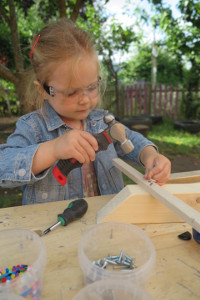
There is something really special about woodwork. It is so different from other activities. The smell and feel of wood, using real tools, working with a natural material, the sounds of hammering and sawing, hands, minds and hearts working together to express their imagination and to solve problems, the use of strength and coordination: all go together to captivate young children’s interest.
Woodwork really stands out for me because of the high and sustained levels of engagement and the sheer enjoyment it provides. Visiting teachers always comment on their deep levels of concentration and engagement, and are further surprised to find the same children still deeply focused working on their creations an hour or two later. It is not unusual children to spend all morning at the woodwork bench.
Initially we observe children working with their hands, constructing models, and working on projects, but in fact the real transformation is inside the child – personal development is at the heart of woodwork.
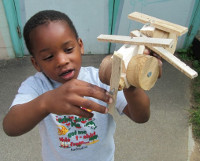
Woodwork is a powerful medium for building self-esteem and confidence. This is for a combination of reasons. Children feel empowered and valued by being trusted and given responsibility to work with real tools. They accomplish tasks that they initially perceive to be difficult and they persist at challenging tasks. They show satisfaction in their mastery of new skills and take immense pride in their creations. This sense of empowerment and achievement provides a visible boost to their self-esteem and self-confidence. Children have a natural desire to construct and build. They learn how things work and discover that they can shape the world around them by making. This imparts a can-do attitude and imbues children with a strong sense of agency – having a proactive disposition towards the world – a belief they can shape their world.
“Every so often a book is written that helps practitioners to develop their work in deep and far reaching ways. This is that sort of book.” Tina Bruce CBE
“The Definitive EY Book for Woodwork. Destined to be a classic.” Juliet Robertson
Excellent in-depth article covering
The Wonder of Woodwork Pete Moorhouse Froebel Trust

Woodwork tools & tips
Recommended woodwork tools from Early Years woodworking expert Pete Moorhouse.
Read More about Woodwork tools & tips
Woodwork & safety
Woodworking in the Early Years expert Pete Woodhouse offers important health and safety guidelines for working with wood.
Read More about Woodwork & safety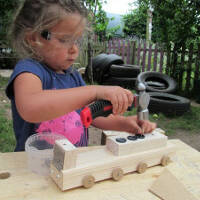
Woodwork & learning
Woodworking in the Early Years expert Pete Woodhouse explores the learning that can come from working with wood.
Read More about Woodwork & learning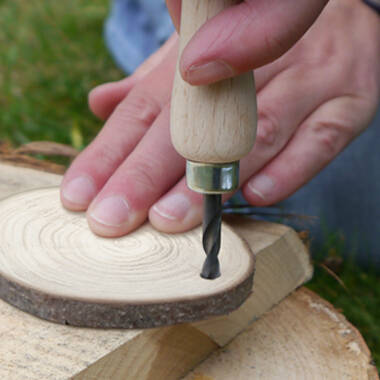
Activities with tools & wood
Some of our woodworking tool guides and simple activities using tools suitable for the Early Years - explore the Outdoor Hub Activity section to find more!
Read More about Activities with tools & woodResearch & reports: wood
A selection of articles on woodworking and working in woodlands, from Early Years children and young people to adults.
We'd love to add more to this section - if you know of any relevant research or reports please send a link to share@muddyfaces.co.uk
Reports & research documents are, as much as possible, arranged in chronological order, most recent at the top
Read More about Research & reports: wood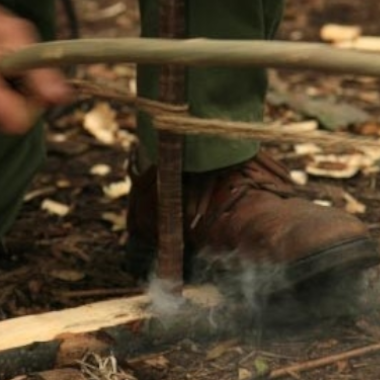
Bushcraft, shelters & traditional crafts
What is bushcraft, what are its benefits, what skills do we need?
How do I create an effective shelter for my group?
Why are traditional crafts so important?
We’ve gathered expert information, books and guides, links to specialist organisations and projects, and articles.
Read More about Bushcraft, shelters & traditional crafts